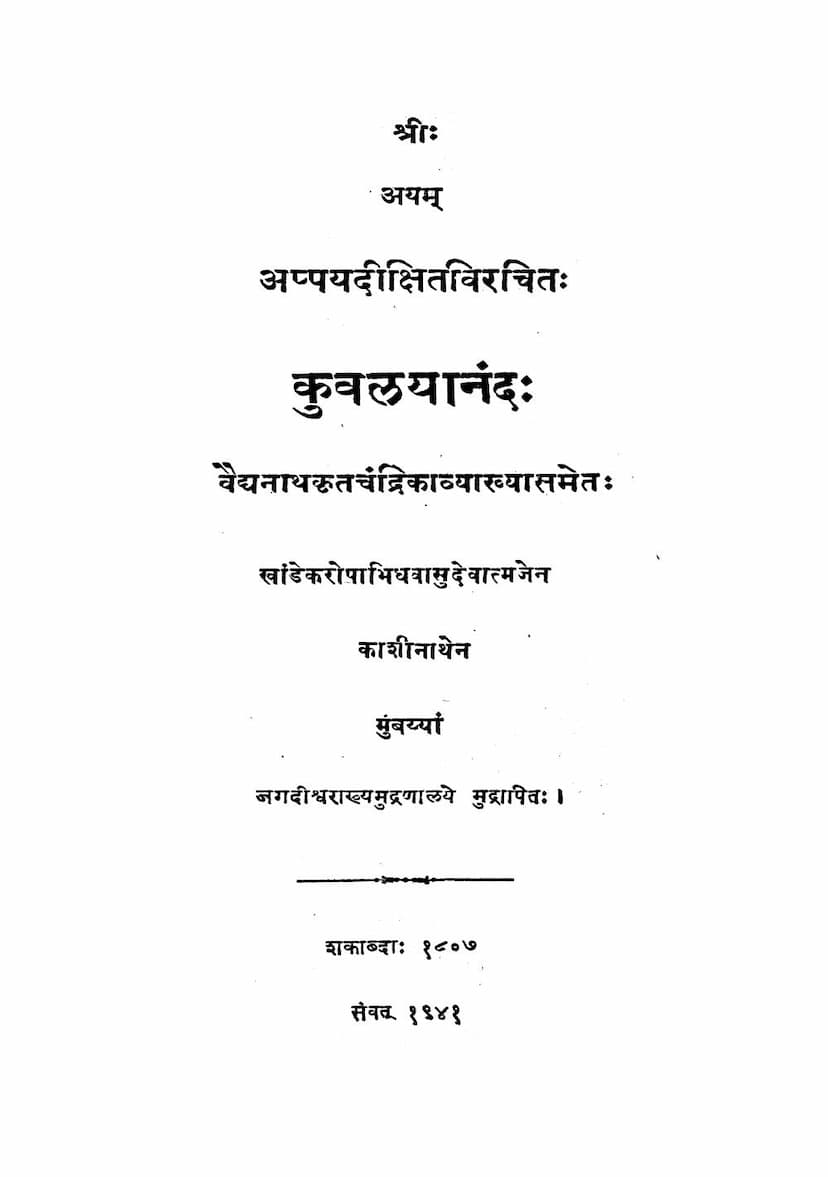Kuvalayanand
Added to library: September 2, 2025

Summary
The following is a comprehensive summary of the Jain text "Kuvalayanand" by Kashinath Vasudev Khandekar, based on the provided catalog link and the content of the first few pages:
Book Title: Kuvalayananda (कुवलयानंद) Author: Appayadikshita (अप्पयदीक्षित) - The text presented is the Kuvalayananda by Appayadikshita, with commentary by Vaidyanath (वैद्यनाथकृतचंद्रिकाव्याख्यासमेतः). Editor/Publisher: Kashinath Vasudev Khandekar (खांडेकरोपाभिधवासुदेवात्मजेन काशीनाथेन), Jagdishwar Mudranalay, Mumbai (मुंबय्यां नगदीश्वराख्यमुद्रणालये). Publication Year: Saka Era 1807 (शकाब्दाः १८०७), Vikram Samvat 1941 (संवत् १९४१).
Overall Summary:
The text is the Kuvalayananda, a well-known treatise on Alankara Shastra (the science of literary embellishments or figures of speech) authored by Appayadikshita. The edition is published by Jagdishwar Mudranalay in Mumbai, edited and published by Kashinath Vasudev Khandekar. It is accompanied by the commentary Chandrika by Vaidyanath.
The Kuvalayananda is a foundational text in Indian poetics, specifically focusing on Artha Alankaras (figures of speech related to meaning). It systematically defines and illustrates various figures of speech, providing a clear understanding of how poets enhance their verses through these stylistic devices.
Key Features based on the provided pages:
-
Title Page (Page 1-2): Clearly identifies the work as Kuvalayananda by Appayadikshita, with the Chandrika commentary by Vaidyanath, and credits Kashinath Vasudev Khandekar as the publisher and printer in Mumbai. The publication year is also provided.
-
Index of Alankaras (Page 3-4): This section is crucial as it provides a comprehensive list of the figures of speech discussed in the Kuvalayananda. It is organized into categories:
- Alankaras (Figures of Speech): A lengthy list of approximately 92 figures of speech is presented, including well-known ones like Upama (simile), Rupaka (metaphor), Utpreksha (hyperbole), Arthāntaranyāsa (statement of general truth to support a specific statement), and many others. The index also lists their corresponding page numbers (or at least their sequence).
- Rasa-related Alankaras (Page 4, starting from line 1): A section listing fifteen Rasa (aesthetic sentiment) related figures of speech, such as Rasavan (possessing rasa), Preyas (lovable), Urjasvin (energetic), Samahita (balanced), Bhavodaya (manifestation of emotion), etc.
- Sankara and Samsṛṣṭi Alankaras (Page 4, towards the end): A section on mixed figures of speech, including Sankara (mixture) and Samsṛṣṭi (combination). Five types of Sankara are listed.
-
Invocation and Introduction (Page 5 onwards):
- Invocation (Mangalacharan): The text begins with an invocation to Goddess Gauri (likely referring to Parvati, the consort of Shiva, in a poetic context common in Sanskrit literature) and Lord Ganesha, seeking blessings for the successful completion of the work.
- Author's Intent: The author, Vaidyanath (in his commentary), states the purpose of the text is to explain the figures of speech in a way that is accessible to beginners (" बालानामवगाहनसिद्धये"). He mentions that the Kuvalayananda itself provides examples for the figures of speech, and where necessary, new examples are composed.
- Influence of Chandraloka: The author notes that many of the examples are drawn from the Chandraloka by Jayadeva, with some new ones composed.
- First Alankara - Upama (Page 7 onwards): The text then begins to systematically explain the figures of speech, starting with Upama (simile). It defines Upama as the presence of similarity between the Upameya (object being compared) and the Upamana (object used for comparison). The commentary elaborates on the nuances of Upama, including the four components (Upameya, Upamana, Samana Dharma, and Upama Vachaka) and various types of Upama. The first example illustrates Upama with the analogy of a swan (Hamsi).
In essence, this document represents a scholarly edition of Appayadikshita's Kuvalayananda, enhanced by Vaidyanath's commentary, making the intricate science of Sanskrit literary figures accessible and comprehensible. It meticulously lists and begins to explain the various Artha Alankaras, highlighting its importance as a pedagogical text in Indian poetics.